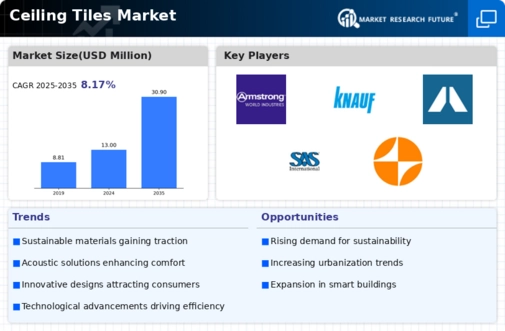Market Trends
Key Emerging Trends in the Ceiling Tiles Market
Manufacturers are interested in exploring new materials for use in ceiling tiles, which is emerging as the newest trend. Other than conventional materials like mineral fiber, plaster, and metal, manufacturers are now working on new materials that deliver better soundproofing, design freedom as well as longevity. People want a lot of style options when they choose ceiling tiles, which is a big move toward customization. In response, manufacturers are offering a wide range of customized options, so customers can make their areas unique by choosing from different colors, patterns, and styles. Ceiling tile styles are becoming more focused on how well they block noise. Because making environments that are comfy and sound-friendly is becoming more important, manufacturers are making ceiling tiles that can absorb sound better. With its focus on sound comfort, this style is perfect for places like offices, schools, and hospitals. Smart technology's rising use in ceiling tiles is the latest trend. Manufacturers are looking into methods to add sensors, lighting systems, and networking features to ceiling tiles for use as smart parts of building design. Metallic textures and finishes are becoming more and more popular in ceiling tile designs. Additions and textures made of metal give rooms a current and classy look. This style of design fits with today's tastes, especially in business settings and high-end homes. Biologically-inspired design elements are affecting the latest ceiling tile styles. Ceiling tiles with textures, colors and designs, that are derived from nature are meant to bring nature inside. It's like the biophilic design trend, which focuses on making buildings more like nature. 3D shapes are changing the way people choose ceiling tiles. Manufacturers are making tiles with complex 3D designs and layers that give ceilings more depth and visual appeal. People want artsy and visually interesting interior design, and this style meets that need. Many people like ceiling tiles that are light and easy to put up. Companies are making things that are easier to handle, which cuts down on installation time and staff costs. This trend matches the rising need for building options that use less energy and cost less. As digital printing technologies become more common, they are changing the designs on ceiling tiles. With this technology, artists can make more designs by using complex patterns, lifelike textures, and bright colors. The move toward digital painting shows a desire for more complex and aesthetically pleasing ceiling tile options. Ceiling tile styles are moving toward looks that are more retro and old. Companies are making tiles that look like they came from a long time ago. These tiles are appealing to people who want to give their homes a classic or nostalgic look. People are choosing different types of ceiling tiles based on their health and happiness. Companies are looking into materials that kill microbes, which will help make living environments better. This trend fits with the rising interest in healthy building design and indoor air quality.








Leave a Comment